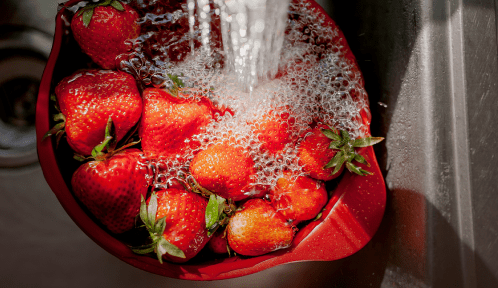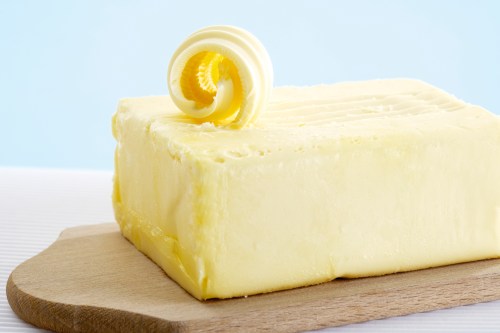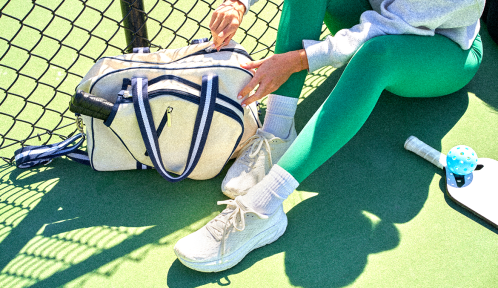Of the all the things to look forward to in spring and summer, high on the list is undoubtedly the arrival of fresh strawberries. What’s sweeter than your first bite into a perfectly ripe ruby red berry? Nothing—save for an ice-cold strawberry smoothie, a bite of protein-rich strawberry cottage cheese ice cream, or another fresh, seasonal strawberry recipe like a refreshing strawberry lemonade sorbet. Swoon.
Experts in This Article
spokesperson for the U.S. Food and Drug Administration (FDA)
foodborne illness expert with the U.S. Food and Drug Administration (FDA)
lead chef-instructor of Plant-Based Culinary Arts at the Institute of Culinary Education‘s Los Angeles campus
While the miracles of modern agriculture have made the most popular berry in the United States available all year long, never are they more delicious than in their natural peak time. The only thing that can ruin something so sweet? Digging into a juicy strawberry coated with a little too much grit and grime from the patch. Ahead, we’re sharing a few food safety tips for how to wash strawberries properly, according to a chef and food safety experts at the U.S. Food and Drug Administration (FDA). The good news? It’s berry (ha) easy to do.
The best way to clean strawberries
According to Missy Smith-Chapman, lead chef-instructor of Plant-Based Culinary Arts at the Institute of Culinary Education‘s Los Angeles campus, you’ll need two ingredients to wash strawberries: water and a bit of baking soda. “The way I like to wash strawberries—and all berries—is in a solution of two teaspoons of baking soda to one quart water,” Smith-Chapman says.
Once the baking soda-water mixture is combined, Smith-Chapman lets the berries soak in the concoction for a few minutes before rinsing them thoroughly (and gently) under cool, running water. She notes that you should see any residue float to the surface. “I wash all my fruits and vegetables, you don’t even realize how much impurities can be on produce,” she says. The baking soda helps to remove any dirt from the surface of the fruit.
“The way I like to wash strawberries—and all berries—is in a solution of two teaspoons of baking soda to one quart water.”
—Missy Smith-Chapman, lead chef-instructor, Plant-Based Culinary Arts at the Institute of Culinary Education
Smith-Chapman says she was first introduced to this method thanks to a food science experiment she came across. “I previously washed produce with a vinegar solution, but after seeing a study in Cook’s Illustrated, where produce that was washed with baking soda came out the cleanest, I converted to this method,” she says. Although, when in a pinch, Smith-Chapman says store-bought vegetable wash will also do. “But baking soda is a more affordable option,” she reiterates. (And arguably more effective, too.)
How to remove pesticides from strawberries
According to the FDA, there are a few easy steps to follow when washing not only strawberries, but any kind of fresh produce to help remove pesticides.
1. Wash your hands before handling the fresh produce
This may sound obvious, but washing your hands before touching fresh produce should be step number one. “When preparing any fresh produce, start with clean hands,” says Amanda Turney, a spokesperson for the FDA. Seems like a no-brainer, but you’d be surprised how often this step gets skipped. “Wash your hands for at least 20 seconds with soap and warm water before and after preparation,” Turney says. This will help prevent the spread of any harmful germs, bacteria, or chemicals to other areas (or foods) in your kitchen.
2. Remove any damaged areas
Once your hands are clean, you’ll want to assess the exterior of the berries and look for any damaged areas. Then, remove any bruised, rotten, or otherwise damaged parts of your strawberries. You don’t have to throw away the whole thing, but if you notice that your produce appears to be moldy anywhere or feels excessively mushy, don’t even bother trying to wash away the damage. In this case, it’s likely safest to discard the entire berry, as consuming moldy foods can cause serious illness.
3. Wash the strawberries under cool, running water
Unlike Smith-Chapman’s baking soda-water approach, the FDA says plain ol’ water is more than enough. As such, you can simply transfer the berries into a colander and run them under cold water, while gently rubbing the outside of the fruit to help dislodge any dirt or grime from the surface. You’ll want to make sure you get each strawberry in the washing process, stems included.
While you may be tempted to use soap or a produce wash, the FDA does not recommend using anything other than water in your washing routine—after all, it isn’t necessary to introduce another chemical into your fruit’s life cycle. However, if they do look severely dirty, you can soak your berries for a couple of minutes in a solution of 1 1/2 cups water and 1/4 cup vinegar (or opt for Smith-Chapman’s technique), then give them a good rinse.
4. Gently pat the strawberries dry
Once your berries are squeaky clean, Turney recommends gently drying them off with a clean paper towel or cloth. “After washing, gently dry strawberries with a clean cloth towel or paper towel to further reduce bacteria that may be present on the surface,” Turney says. You can lay them down on a towel to speed up the drying process, too.
How to keep strawberries fresher for longer
The key to keeping strawberries fresh for longer is consuming them in a timely manner after you’ve brought them home (and washed them). As such, you’ll want to serve your berries soon, as washing your strawberries ahead of time may make them mushy and speed up the spoiling process due to the added moisture.
If you aren’t eating them immediately, Glenda Lewis, a foodborne illness expert with the FDA, says to store them in the fridge until you’re ready to nosh. Additionally, if you plan on cutting your strawberries for a fruit salad or a smoothie, she advises doing so after you’ve already washed them to prevent the transfer of dirt, bacteria, or chemicals.
How to store strawberries to keep them fresh
According to Smith-Chapman, the best way to store strawberries is by drying them very thoroughly after they’re washed, and storing them in a single layer on a paper towel or on top of an absorbent towel in an airtight container in the refrigerator. She notes that if you follow these steps, your fresh strawberries should last about a week.
The key is to eliminate as much moisture from the exterior as possible.
Should you wait to wash your strawberries until right before eating them?
While you may be tempted to wait until you wash your strawberries until right before you’re ready to dig into them, Smith-Chapman strongly urges folks to do the prep work ahead of time.
“Many people think washing fruit and vegetables will make them degrade, but if one strawberry is super ripe at the bottom of your container, then the whole box can start to mold. Washing ahead of time also makes it convenient to just reach in and eat or use fresh fruit,” she says.
Can you freeze strawberries?
Can’t make it through your entire strawberry stash before it starts to grow mold? Smith-Chapman says you can freeze them instead. “Wash and dry them as directed above, and place the container in the freezer. Once frozen, you can move them into another bag to store. I have a bag of frozen fruit in my freezer that is my ‘smoothie bag’ that I continuously add fruit to,” she says.
Pro tip: Smith-Chapman keeps the stems on (goodbye, food waste). “The tops of strawberries are edible, so I don’t remove them before freezing and add the whole fruit to a smoothie,” she says. Berry smart!
Pro tip: Smith-Chapman keeps the stems on (goodbye, food waste). “The tops of strawberries are edible, so I don’t remove them before freezing and add the whole fruit to a smoothie,” she says.
Why cleaning strawberries is key
Each year, the Environmental Working Group (EWG) releases a list of the 12 fruits and vegetables with the highest levels of pesticide residue based on samples collected by the U.S. Department of Agriculture (USDA) and the FDA. And in 2024—and seven-plus years prior—the “dirtiest” of the dozen is none other than the beloved strawberry. To be clear, this doesn’t imply that you should avoid consuming strawberries by any means. On the contrary, simply knowing how to wash strawberries correctly is more than enough.
Given the ubiquity of strawberries in the United States—the University of Illinois estimates that around 94 percent of American households consume strawberries, and the average American eats about eight pounds of fresh strawberries a year—it’s hard to imagine that they’ve been found to contain more pesticide residue than any other form of produce. But this reality is due in part to the way that strawberries are grown.
Unlike most fruits that grow on vines or from trees, strawberries grow directly in soil, which contains its own pesticides and fertilizers. In addition, many fruits that have been found to contain fewer pesticide residue, like bananas and oranges, have a peel—aka nature’s built-in “packaging”—that helps protect their edible insides from the effects of contamination. Strawberries don’t have such a luxury. Finally, strawberries are popular among pests and other animals (we get it), which makes some farmers a *bit* trigger happy when it comes to spraying down the fruit.
All of the above is nothing to lose sleep over, but underscores the importance of rinsing your ruby reds. To reiterate, you should absolutely continue to relish strawberries in every form (alongside all of the other fruits and vegetables that rank high on the “Dirty Dozen” list). But learning how to wash strawberries with the guidance of experts can potentially help spare you some concern.
Why the ‘Dirty Dozen’ should *not* be cause for too much concern
BTW, if you took a longer look at the Dirty Dozen list and found yourself wondering whether you should just cancel strawberry season entirely to avoid pesticide potential, we’re here to talk you down. While pesticides are certainly not meant to be ingested, the good news is that a solid cleaning session does a great job of washing these chemicals off your fresh produce. So don’t fret or stop eating fresh fruits and vegetables—just make sure that you’re following the protocol above before eating or using them.
If you’re looking for another way to reduce the number of pesticides in your diet, buying organic could also help. The USDA only allows produce to be classified as organic if it’s been verified to be grown in soil without any “prohibited substances” (like synthetic fertilizers and pesticides) for three years before harvest. That said, given how easy it is to clean strawberries, if you find the price of organic produce prohibitive, there’s no need to panic. Just learn how to wash produce like a pro and give your non-organic fruits and veggies a thorough rinse and you’re good to go.
To find out more about the Dirty Dozen list (and why you shouldn’t necessarily skip any of the produce on it), see here:
Sign Up for Our Daily Newsletter
Get all the latest in wellness, trends, food, fitness, beauty, and more delivered right to your inbox.
Got it, you've been added to our email list.











